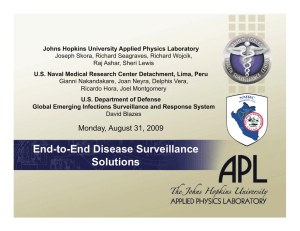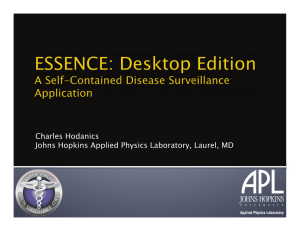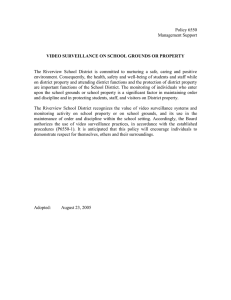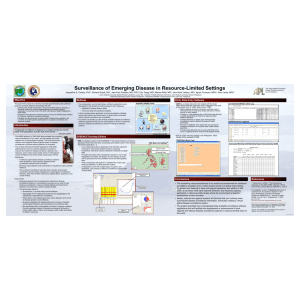Public Health Informatics Tools for Electronic Disease Surveillance in Resource-Limited Settings
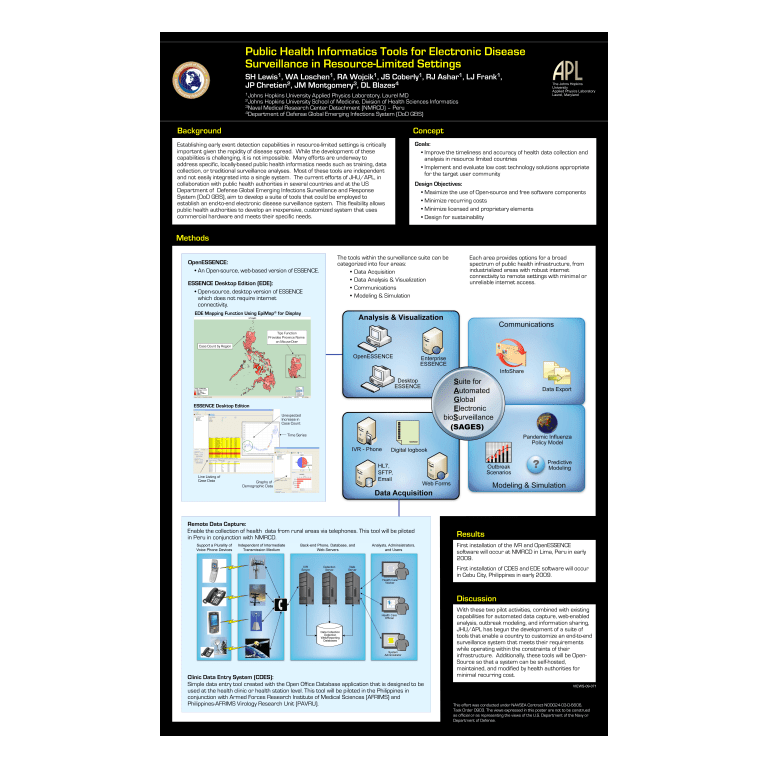
Public Health Informatics Tools for Electronic Disease
Surveillance in Resource-Limited Settings
SH Lewis
1
, WA Loschen
1
, RA Wojcik
1
, JS Coberly
1
, RJ Ashar
1
, LJ Frank
1
,
JP Chretien
2
, JM Montgomery
3
, DL Blazes
4
1 Johns Hopkins University Applied Physics Laboratory, Laurel MD
2 Johns Hopkins University School of Medicine, Division of Health Sciences Informatics
3 Naval Medical Research Center Detachment (NMRCD) – Peru
4 Department of Defense Global Emerging Infections System (DoD GEIS)
Background
Establishing early event detection capabilities in resource-limited settings is critically import ant given the rapidity of disease spread. While the development of these capabilities is challenging, it is not impossible. Many efforts are underway to address specific, locally-based public health informatics needs such as training, data collection, or traditional surveillance analyses. Most of these tools are independent and not easily integrated into a single system. The current efforts of JHU/APL, in collaboration with public health authorities in several countries and at the US
Department of Defense Global Emerging Infections Surveillance and Response
System (DoD GEIS), aim to develop a suite of tools that could be employed to establish an end-to-end electronic disease surveillance system. This flexibility allows public health authorities to develop an inexpensive, customized system that uses commercial hardware and meets their specific needs.
The Johns Hopkins
University
Applied Physics Laboratory
Laurel, Maryland
Concept
Goals:
• Improve the timeliness and accuracy of health data collection and analysis in resource limited countries
• Implement and evaluate low cost technology solutions appropriate for the target user community
Design Objectives:
• Maximize the use of Open-source and free software components
• Minimize recurring costs
• Minimize licensed and proprietary elements
• Design for sustainability
Methods
OpenESSENCE:
• An Open-source, web-based version of ESSENCE.
ESSENCE Desktop Edition (EDE):
• Open-source, desktop version of ESSENCE which does not require internet connectivity.
EDE Mapping Function Using EpiMap
©
for Display
The tools within the surveillance suite can be categorized into four areas:
• Data Acquisition
• Data Analysis & Visualization
• Communications
• Modeling & Simulation
Each area provides options for a broad spectrum of public health infrastructure, from industrialized areas with robust internet connectivity to remote settings with minimal or unreliable internet access.
Tips Function
Provides Province Name on Mouse-Over
Case Count by Region
ESSENCE Desktop Edition
Unexpected
Increase in
Case Count
Time Series
Line Listing of
Case Data
Graphs of
Demographic Data
Remote Data Capture:
Enable the collection of health data from rural areas via telephones. This tool will be piloted in Peru in conjunction with NMRCD.
Clinic Data Entry System (CDES):
Simple data entry tool created with the Open Office Database application that is designed to be used at the health clinic or health station level.
This tool will be piloted in the Philippines in conjunction with Armed Forces Research Institute of Medical Sciences (AFRIMS) and
Philippines-AFRIMS Virology Research Unit (PAVRU).
Results
First installation of the IVR and OpenESSENCE software will occur at NMRCD in Lima, Peru in early
2009.
First installation of CDES and EDE software will occur in Cebu City, Philippines in early 2009.
Discussion
With these two pilot activities, combined with existing capabilities for automated data capture, web-enabled analysis, outbreak modeling, and information sharing,
JHU/APL has begun the development of a suite of tools that enable a country to customize an end-to-end surveillance system that meets their requirements while operating within the constraints of their infrastructure. Additionally, these tools will be Open-
Source so that a system can be self-hosted, maintained, and modified by health authorities for minimal recurring cost.
VIEWS-09-071
This effort was conducted under NAVSEA Contract N00024-03-D-6606,
Task Order 0903. The views expressed in this poster are not to be construed as official or as representing the views of the U.S. Department of the Navy or
Department of Defense.
